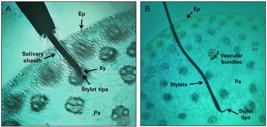Abstract
The Neotropical green-belly stink bug, Dichelops melacanthus (Dallas) is a major pest of maize, Zea mays L. in the main production areas of Brazil. It usually feeds on the stems of young plants (seedlings) causing heavy damage by affecting the plant growth and mitigating seed yield. Laboratory studies were conducted to determine body position (upward or downward) of the bug on plant (seedling) stem during feeding and not feeding activities. Ten visual records were taken per day, each spaced one hour during 30 days of 10 adult bugs of similar age exposed to maize seedlings inside cages (plastic tubes). At each observation, it was recorded if the bug was feeding on the stem (i.e., stylets inserted into the plant tissue) or not, and its body position. During feeding, waveforms were recorded using the EPG (electropenetrography) technique, which were correlated with histological studies to reveal the feeding sites. Results indicated that when they were feeding, the majority of the bugs were in the downward position. In contrast, when the bugs were on the plants, and not feeding, they were mostly in the upward position. Waveforms generated using the EPG coupled with histological studies demonstrated that during ingestion bugs fed from the xylem vessels and from the parenchyma tissue using cell rupture strategy in the latter. No clear explanation was found to explain the preferred downward body position during ingestion, but some hypothesis are speculated.
Keywords:
Heteroptera; Pentatomidae; feeding behavior; EPG, plant histology

 Thumbnail
Thumbnail
 Thumbnail
Thumbnail
 Thumbnail
Thumbnail
 Thumbnail
Thumbnail



